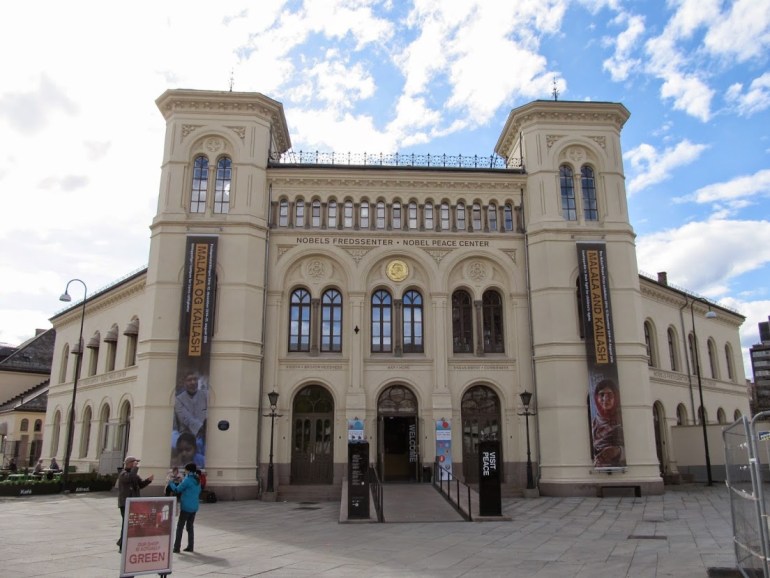
After virtually being awake for 36 hours straight, our day in Oslo afforded us the opportunity to sleep in….all the way to 8:30.
Oslo was split up into two parts. The first half was a guided tour, which brought us to the Vigeland Sculpture Park, the famous Oslo ski jump Holmenkollbakken and the Viking Ship Museum. The second half allowed us to walk around the city and eat lunch on our own.

Our tour guide Gerda was an older Norwegian woman with a moderate accent. She did a good job of narrating the various neighborhoods and buildings we passed as we made our way from place to place along the tour. We saw the Nobel Peace Center, which happens to the be the only Nobel Prize they award in Oslo (the rest are in Stockholm). Many of the buildings on the way to the sculpture park were associated with the government or were appropriated as living for foreign governments. One of the most unusual sights for an American is to see where Prime Minister Erna Solberg lives, which is merely another house among many.

The Vigeland Sculpture Park was a stunning bit of artistic escape inside the larger Frogner Park. Gustav Vigeland was a progressive sculptor who came to prominence during the turn of the 20th century. His work, which leans heavily on a variety of nudes, was shocking for Norwegians at the park’s inception. We spent about forty-five minutes on a guided tour of the park, with opportunities to split away from the group for additional photography.
Next, our tour bus climbed the mountain to Holmenkollbakken. This was a nice rest from walking through the park and allowed us to get some fantastic views out into the Fjord where Oslo sits. This next stop was relatively brief, but interesting. The sheer size of the ski jump was overwhelming and it was very neat to visit such a renowned sports venue. Across the way was a stave church, which was also a treat.

Our final tour stop was the Viking Ship museum. This small, but packed venue had three viking ships, one of which was preserved almost entirely intact. There were walk-ups at the corners of these sections so you could get a better look at the ships’ decks and get a sense for how they would have operated. Accompanying these main attractions were several display cases filled with artifacts recovered from both viking expeditions and life at home. As someone with a healthy historical curiosity, exposure to less highlighted cultures captures my interest much more than revisiting the same western European, Roman-centric areas.
About the time the tour bus dropped us back at the ship, we were ready for lunch. We opted to forgo seeking out traditional Norwegian fare, especially from our limited radius away from the touristy port area. Instead, we found Nydalen Bryggeri og Spiseri, a microbrewery and American style brewpub that not only peddled its own wares, but also boasted an extensive beer list with tons of American craft brews. We opted to try some Norwegian beers and I ordered their cheeseburger, which was on point to what you’d find at a similar restaurant here at home. While we were sitting outside at lunch, we witnessed the dispersing of a large crowd gathered for Name Day celebrations, which is their secular alternative to traditional baptism ceremonies.

Our last stop of the day was to walk down Aker Brygge, a waterfront promenade of shops and restaurants. There was a TGI Fridays, which was supremely upsetting, McDonald’s is obviously ubiquitous around the world, but some things just look out of place abroad. There were some clowns walking around this area with painted smiles and real scowls who were aggressively trying to sell balloon animals to frightened children. One was even smoking. Despite this strangeness, the promenade offered some more great views of both the Fjord and the cruise ship and it was a nice way to end the day in Norway.
After dinner, we ventured to the ship’s stern and watched the Fjord disappear behind us as the sun set at 9:18. There is something profoundly uplifting about sunlight that never ends. Over the two weeks at sea, I quickly became accustomed to seeing the sun well into the evening and now that I’m back I miss it dearly.
Next Stop: Aarhus.



 It’s a great time of the year to travel to Lilliput, a gorgeous island nation in the South Indian Ocean. Though there are some great tourist spots, foreigners have had some trouble on the island, and so it’s important to understand some of the local culture and customs before making the trip.
It’s a great time of the year to travel to Lilliput, a gorgeous island nation in the South Indian Ocean. Though there are some great tourist spots, foreigners have had some trouble on the island, and so it’s important to understand some of the local culture and customs before making the trip.